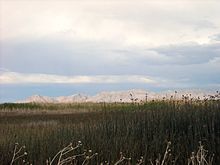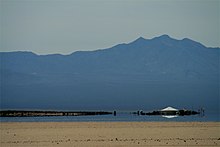What is oasis?
In geography, an oasis (/oʊˈeɪsɪs/; plural:oases /oʊˈeɪsiːz/) is an isolated area in adesert, typically surrounding a spring or similar water source, such as a pond or small lake. Oases also provide habitat for animals and even humans if the area is big enough. The location of oases has been of critical importance for trade and transportation routes in desert areas; caravans must travel via oases so that supplies of water and food can be replenished. Thus, political or military control of an oasis has in many cases meant control of trade on a particular route. For example, the oases of Awjila, Ghadames, andKufra, situated in modern-day Libya, have at various times been vital to both North-South and East-West trade in the Sahara Desert.
Oases are formed from underground rivers or aquifers such as an artesian aquifer, where water can reach the surface naturally by pressure or by man-made wells. Occasional brief thunderstorms provide subterranean water to sustain natural oases, such as theTuat. Substrata of impermeable rock and stone can trap water and retain it in pockets, or on long faulting subsurface ridges or volcanic dikes water can collect and percolate to the surface. Any incidence of water is then used by migrating birds, which also pass seeds with their droppings which will grow at the water's edge forming an oasis. It can also be used to plant crops.
Etymology
The word oasis came into English via Latin:oasis from Ancient Greek: ὄασις óasis, which in turn is a direct borrowing from Demotic Egyptian. The word for oasis in the later attested Coptic language (the descendant of Demotic Egyptian) is wahe or ouahe which means a "dwelling place".[1]
Growing plants
People who live in an oasis must manage land and water use carefully; fields must be irrigated to grow plants like apricots, dates,figs, and olives. The most important plant in an oasis is the date palm, which forms the upper layer. These palm trees provide shade for smaller trees like peach trees, which form the middle layer. By growing plants in different layers, the farmers make best use of the soil and water. Many vegetables are also grown and some cereals, such as barley,millet, and wheat, are grown where there is more moisture.[2]
See also
- Great Man-Made River – the world's largest irrigation project; developed in Libya to connect cities with fossil water.
- Guelta
- Mirage
- Oasification
- Qanat
- Wadi
- Water supply

Various kinds of mirages in one location taken over the course of six minutes, not shown in temporal order. The uppermost inset frame shows an inferior mirage of theFarallon Islands. The second inset frame is the Farallon Islands with a green flash on the left-hand side. The two lower frames and the main frame all show superior mirages of the Farallon Islands. In these three frames, the superior mirages evolve from a 3-image mirage (an inverted image between two erect ones) to a 5-image mirage, and then back to a 2-image mirage. Such a display is consistent with a Fata Morgana. All frames but the upper one were photographed from about 50–70 feet above sea level. The upper frame was photographed from sea level.
A mirage is a naturally occurring optical phenomenon in which light rays bend to produce a displaced image of distant objects or the sky. The word comes to English via theFrench mirage, from the Latin mirari, meaning "to look at, to wonder at". This is the same root as for "mirror" and "to admire".
Mirages can be categorized as "inferior" (meaning lower), "superior" (meaning higher) and "Fata Morgana", one kind of superior mirage consisting of a series of unusually elaborate, vertically stacked images, which form one rapidly changing mirage.
In contrast to a hallucination, a mirage is a real optical phenomenon that can be captured on camera, since light rays are actually refracted to form the false image at the observer's location. What the image appears to represent, however, is determined by the interpretive faculties of the human mind. For example, inferior images on land are very easily mistaken for the reflections from a small body of water.
Inferior mirage
For exhausted travelers in the desert, an inferior mirage may appear to be a lake of water in the distance. An inferior mirage is called "inferior" because the mirage is located under the real object. The real object in an inferior mirage is the (blue) sky or any distant (therefore bluish) object in that same direction. The mirage causes the observer to see a bright and bluish patch on the ground in the distance.
Light rays coming from a particular distant object all travel through nearly the same air layers and all are bent over about the same amount. Therefore, rays coming from the top of the object will arrive lower than those from the bottom. The image usually is upside down, enhancing the illusion that the sky image seen in the distance is really a water or oil puddle acting as a mirror.
Inferior images are not stable. Hot air rises, and cooler air (being more dense) descends, so the layers will mix, giving rise to turbulence. The image will be distorted accordingly. It may be vibrating; it may be vertically extended (towering) or horizontally extended (stooping). If there are several temperature layers, several mirages may mix, perhaps causing double images. In any case, mirages are usually not larger than about half a degree high (same apparent size as the sun and moon) and from objects only a few kilometers away.
Heat haze
Heat haze, also called heat shimmer, refers to the inferior mirage experienced when viewing objects through a layer of heated air; for example, viewing objects across hot asphaltor through the exhaust gases produced by jet engines. When appearing on roads due to the hot asphalt, it is often referred to as a highway mirage.
Convection causes the temperature of the air to vary, and the variation between the hot air at the surface of the road and the denser cool air above it creates a gradient in the refractive index of the air. This produces a blurred shimmering effect, which affects the ability to resolve objects, the effect being increased when the image is magnified through atelescope or telephoto lens.
Light from the sky at a shallow angle to the road is refracted by the index gradient, making it appear as if the sky is reflected by the road's surface. The mind interprets this as a pool of water on the road, since water also reflects the sky. The illusion fades as one gets closer.
On tarmac roads it may look as if water, or even oil, has been spilled. These kinds of inferior mirages are often called "desert mirages" or "highway mirages". Both sand and tarmac can become very hot when exposed to the sun, easily being more than 10 °C hotter than the air one meter above, enough to create conditions suitable for the formation of the mirage.
Heat haze is not related to the atmospheric phenomenon of haze.







Comments
Post a Comment